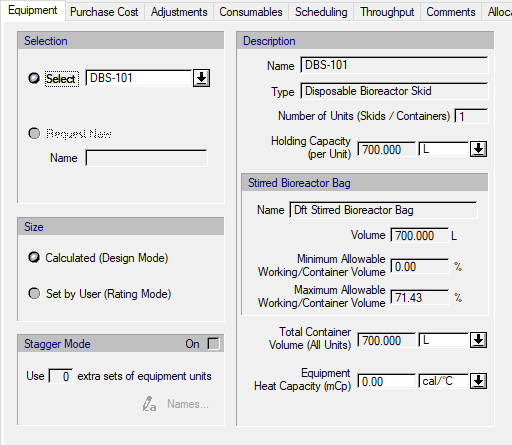

The following table shows the meaning of the variables appearing in this tab, as well as their default values and their generally acceptable range. Note that due to the manner by which the variables are used by the sizing and costing equations, the range of acceptable values may be further reduced.
|
Variable |
Default Value |
Range |
|
|
||
|
◙ Holding Capacity (per Unit) |
700.0 L |
Positive |
|
● Name (of Container) |
Dft Stirred Bioreactor Bag |
|
|
● Volume (of Container) |
700.0 L |
Positive |
|
● Minimum Allowable Working/Container Volume (of Container) |
0.0 % |
Positive |
|
● Maximum Allowable Working/Container Volume (of Container) |
71.43 % |
Positive |
|
● Total Container Volume |
700.0 L |
Positive |
|
○ Equipment Heat Capacity |
0 kcal/°C |
Positive. |
Symbol Key: ○ User-specified value (always input); ● Calculated value (always output); ◙ Sometimes input, sometimes output
A Disposable Bioreactor requires the use of a ‘Stirred Bioreactor Bag’ consumable. The default consumable used is a ‘Dft Stirred Bioreactor Bag’. For information on how to select the required consumable and additional consumables, see Disposable Generic Container Skid: Consumables Tab.
Sizing will determine the number of equipment units (or skids or containers) required to retain the liquid volume dictated by the simulation. In both Design and Rating mode, the user must select the consumable (a member of the ‘Stirred Bioreactor Bag’ type) to be used by this equipment. Furthermore:
● If the Size option is set to “Calculated (Design Mode)”, then the program will compute the total number of units (skids or containers) required based on the total container volume demand that is specified by the operations carried out as part of the (one or more) unit procedures hosted by the equipment resource. Typically, even during the span of a single procedure, more than one operations may demand different volumes. The software will size the vessel based on the largest demand on total container volume amongst all operations executed in the vessel. If that volume exceeds the single container volume specification then the software will assume multiple number of identical units (skids or containers), each with a holding capacity equal to the volume of a single container. For each operation, the operation’s demand on liquid volume is divided by the operation’s max allowable working to vessel volume ratio to determine the operation’s total container volume demand. The equipment’s min and max allowable working to container volume ratio limits act as constraints on the operation’s min and max allowable working to vessel volume ratio limits (i.e., the operation’s min and max working to vessel volume ratio limits must be within the range defined by the equipment’s min and max working to container volume ratio limits).
● If the Size option is set to “Set by User (Rating Mode)”, then the user must set the number of units. From this, and the maximum allowable working to vessel volume ratio (i.e., the maximum fill percent allowed per container) of each operation, the program will calculate for each operation the final working to vessel volume ratio (per cycle), and it will use this to determine if there’s enough storage capacity to hold the required volume. If not, an error will be generated mentioning that the operation’s max allowable working to vessel volume ratio has been exceeded.
The equipment purchase cost is based on holding capacity. It is supplied by the built-in model for 2010 and for CS as material of construction.
● Equipment Heat Capacity; the product of equipment mass times its specific heat capacity. It is used by operations that are executed in the vessel and involve heating and/or cooling. If part of the heat exchange is directed to the vessel, then this variable is used to estimate heating/cooling losses.
For information on the left-hand and top right-hand side variables and options, see Equipment Data Dialog: Equipment tab.